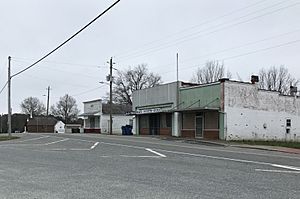Staley, North Carolina facts for kids
Quick facts for kids
Staley, North Carolina
|
|
|---|---|

Buildings along Main Street in Staley
|
|

Location of Staley, North Carolina
|
|
| Country | United States |
| State | North Carolina |
| County | Randolph |
| Founded | 1883 |
| Incorporated | 1901 |
| Named for | John W. Staley |
| Area | |
| • Total | 1.16 sq mi (3.00 km2) |
| • Land | 1.16 sq mi (3.00 km2) |
| • Water | 0.00 sq mi (0.00 km2) |
| Elevation | 725 ft (221 m) |
| Population
(2020)
|
|
| • Total | 397 |
| • Density | 342.54/sq mi (132.21/km2) |
| Time zone | UTC-5 (Eastern (EST)) |
| • Summer (DST) | UTC-4 (EDT) |
| ZIP code |
27355
|
| Area code(s) | 336 |
| FIPS code | 37-64380 |
| GNIS feature ID | 2407394 |
Staley is a small town located in Randolph County, North Carolina, in the United States. In 2020, about 397 people lived there. It's a quiet place with a rich history.
Contents
Discovering Staley's Past
Staley was founded in 1883 and officially became a town in 1901. It is named after John W. Staley.
Historic Buildings in Staley
The Marley House is an important old building in Staley. It was added to the National Register of Historic Places in 1990. This means it's a special place recognized for its historical value.
Early Settlers of Staley
One of the first families to settle here was led by Jacob Leyenberger. He came from Germany and arrived in America in 1739. Jacob and his wife, Elizabeth Quarter, moved to North Carolina in 1758. They traveled along the Great Wagon Road to what is now Chatham and Randolph counties. They raised ten children and are buried near Brush Creek.
Staley's Location and Size
Staley is located in Randolph County, North Carolina. The town covers a total area of about 1.2 square miles (3.0 square kilometers). All of this area is land, with no large bodies of water inside the town limits.
Who Lives in Staley?
The number of people living in Staley has changed over the years. Here's how the population has grown:
| Historical population | |||
|---|---|---|---|
| Census | Pop. | %± | |
| 1920 | 157 | — | |
| 1930 | 241 | 53.5% | |
| 1940 | 255 | 5.8% | |
| 1950 | 236 | −7.5% | |
| 1960 | 260 | 10.2% | |
| 1970 | 239 | −8.1% | |
| 1980 | 204 | −14.6% | |
| 1990 | 204 | 0.0% | |
| 2000 | 347 | 70.1% | |
| 2010 | 393 | 13.3% | |
| 2020 | 397 | 1.0% | |
| U.S. Decennial Census | |||
In 2000, there were 347 people living in Staley. The town had 125 households, which are groups of people living together. Most of these were families.
A Look at the Community
About 28% of the people in Staley were under 18 years old in 2000. The average age of people living in the town was 36 years old. The community is made up of people from different backgrounds. About 82% were White, and there were also African American, Native American, and other races. About 10% of the population identified as Hispanic or Latino.
See also
 In Spanish: Staley para niños
In Spanish: Staley para niños

